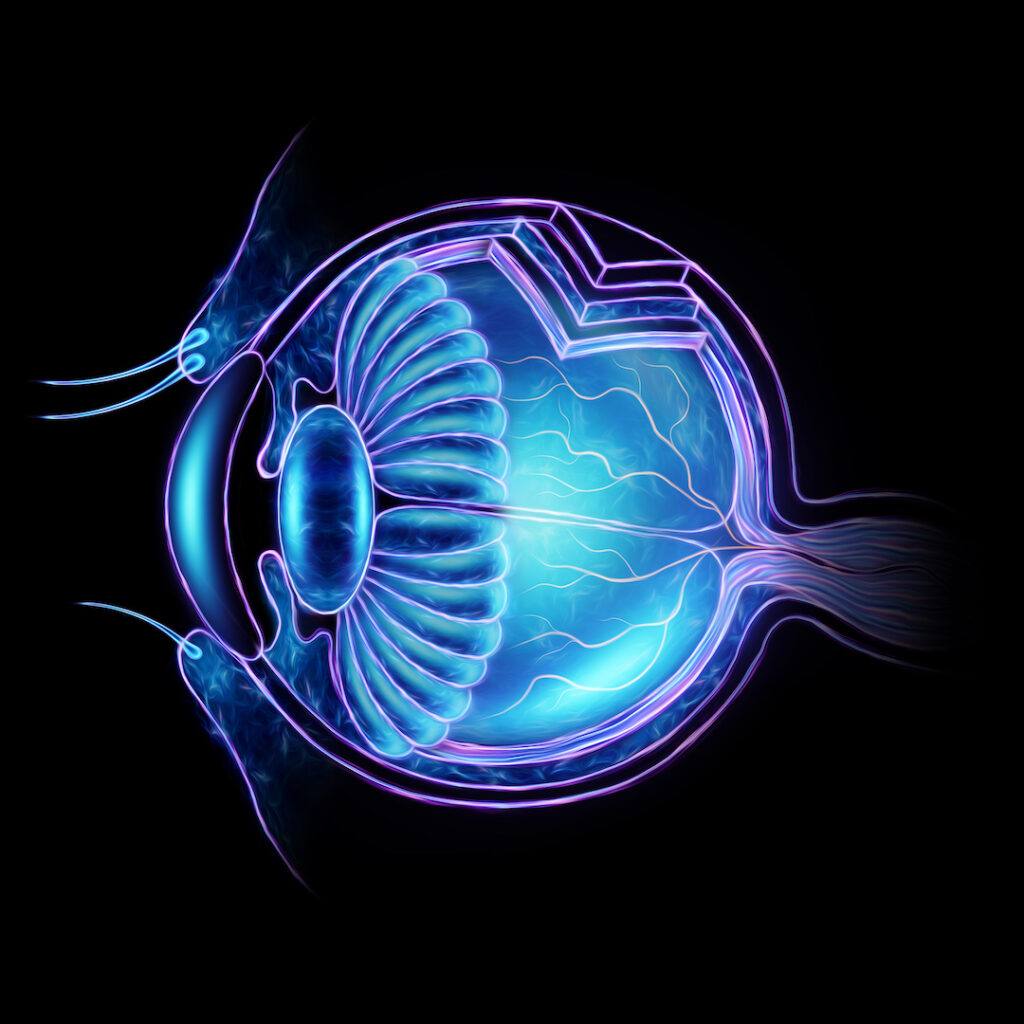Photodynamic Therapy Offers Non-Invasive Solution for Bullous Retinal Detachment
(Posted on Thursday, December 7, 2023)

Realistic human eye hologram, cross sectional cut, isolate side view on black background. Healthcare concept, vision, catheract, ostegmatism, laser eye surgery. 3D illustration, 3D render.
This article was published on Forbes on 11/28/2023.
This story is part of a series on the current progression in Regenerative Medicine. This piece is part of a series dedicated to the eye and improvements in restoring vision.
In 1999, I defined regenerative medicine as the collection of interventions that restore to normal function tissues and organs that have been damaged by disease, injured by trauma, or worn by time. I include a full spectrum of chemical, gene, and protein-based medicines, cell-based therapies, and biomechanical interventions that achieve that goal.
The human eye is a miraculous work of nature, enabling us to perceive the world in all its beauty. However, sometimes, even the most intricate mechanisms of the eye can malfunction, leading to debilitating conditions such as retinal detachment.
This medical emergency demands immediate attention and is characterized by sudden vision loss, floaters, flashes of light, and more. Bullous retinal detachment is a specific type that forms a blister, potentially causing significant damage, often leading to permanent vision loss. While current surgical methods offer successful outcomes, they require a long and invasive recovery period.
Patients suffering from bullous retinal detachment may have a new, non-invasive alternative to surgical intervention in the form of photodynamic therapy (PDT). This therapy shows a lot of promise in improving patients’ visual prognosis. In this article, we delve into the details of PDT, exploring how it works and the current limitations of this treatment.
What is Retinal Detachment?
Retinal detachment is a medical emergency that requires immediate attention. It is a condition that occurs when the retina, which is the thin layer of tissue at the back of the eye, becomes separated from the underlying tissue. This separation can be caused by injury, disease, or other factors. The most common symptom of retinal detachment is sudden, painless vision loss, often described as a curtain-like shadow that moves across the field of vision. Other symptoms may include flashes of light, floaters, or the appearance of a veil or cobweb in the affected eye.
Bullous retinal detachment is a specific type of retinal detachment that is characterized by the formation of a large, fluid-filled blister or bulla in the retina. This blister can cause significant damage to the retina and can lead to permanent vision loss if left untreated. Bullous retinal detachment is often caused by trauma to the eye. Still, it can also be the result of underlying medical conditions such as diabetes or high blood pressure. Treatment for bullous retinal detachment may include surgery to repair the damaged retina and restore vision or laser therapy to prevent further damage.
Current Treatments
Currently, the most common methods of treating it involve surgical intervention such as scleral buckling or vitrectomy. In scleral buckling, a silicone band or sponge is placed around the eye to push the wall of the eye against the detached retina and help hold it in place. In vitrectomy, the surgeon removes the vitreous, clear gel from the eye and replaces it with a gas or oil bubble to help push the retina back in place.
While these procedures can be successful in many cases, they are also invasive and require a significant recovery period. Patients may experience discomfort, blurred vision, and sensitivity to light during the recovery period, which can last several weeks. However, with proper care and follow-up appointments with their doctor, patients can expect to regain their vision and return to normal activities over time.
Photodynamic Therapy for Bullous Retinal Detachment
Photodynamic therapy (PDT) is a non-invasive treatment option that has shown promise in managing various retinal diseases, including bullous retinal detachment. PDT involves using a photosensitizing agent, such as indocyanine green (ICG), injected into the patient’s bloodstream. The photosensitizer is then activated by a low-power laser, which causes damage to the blood vessels that supply the affected area of the retina. This damage leads to the formation of a clot, which seals off the area and prevents any further fluid leakage or bleeding.
A study published in Graefe’s Archive for Clinical and Experimental Ophthalmology evaluated the efficacy of half-dose PDT for treating bullous retinal detachment. Six patients with bullous retinal detachment received half-dose photodynamic therapy (PDT). The treatment was guided by a medical imaging technique called indocyanine green angiography (ICGA).
It uses laser spots that cover multiple areas. After the treatment, the patient’s retinas were reattached, and the fluid underneath the retina disappeared. Three months later, the patient’s vision improved significantly. One patient needed a second treatment because the sub-retinal fluid persisted, but eventually, their detachment resolved successfully.
While the results of this study are promising, there are several limitations to consider. The sample size was small, and there was no control group for comparison. Additionally, the follow-up period was relatively short, at only six months, so it is unclear how these patients will fare in the long term. Further research is needed to determine the optimal dosages and treatment parameters for PDT in managing bullous retinal detachment.
Toward the Future
Despite these limitations, PDT offers a non-invasive alternative to surgical intervention for treating bullous retinal detachment. It is less invasive and may recover faster than traditional surgical approaches. Additionally, PDT is effective in treating other retinal diseases, such as age-related macular degeneration, so there is potential for its use in a wide range of conditions.
In conclusion, photodynamic therapy has demonstrated promising results in managing bullous retinal detachment. Its non-invasive nature, coupled with its efficacy in other retinal diseases, makes it an attractive alternative to traditional surgical approaches. While further research is needed to determine the optimal treatment parameters, this therapy offers hope for improved visual outcomes for patients with this condition.
To learn more about the eye, read more stories at www.williamhaseltine.com

